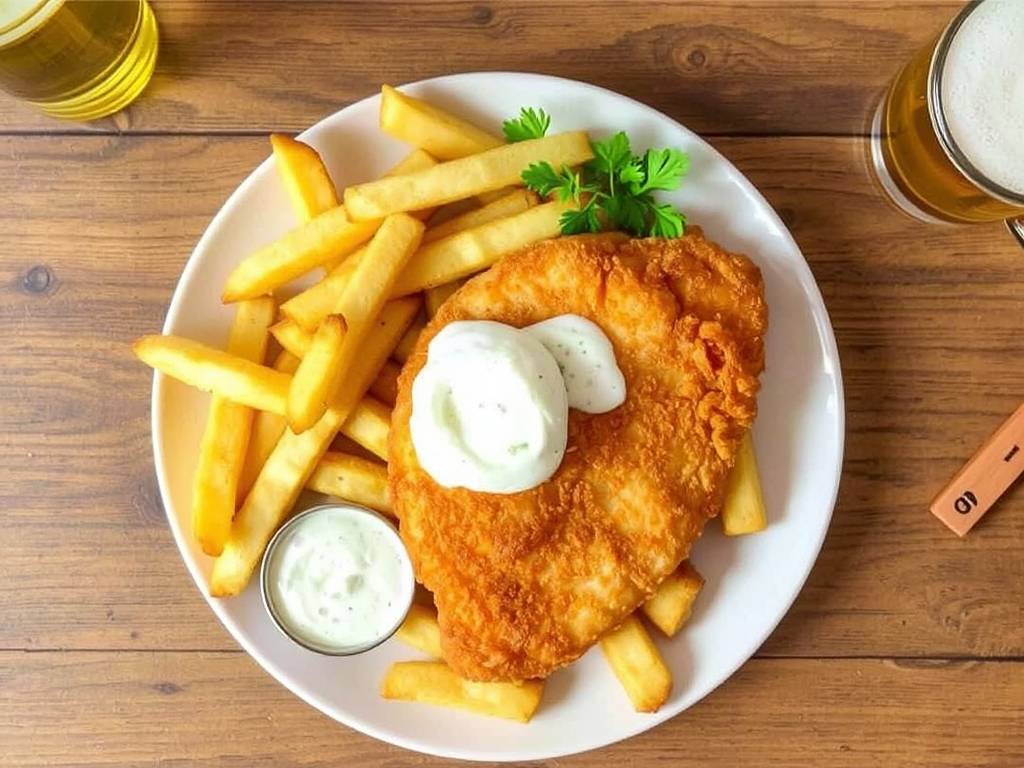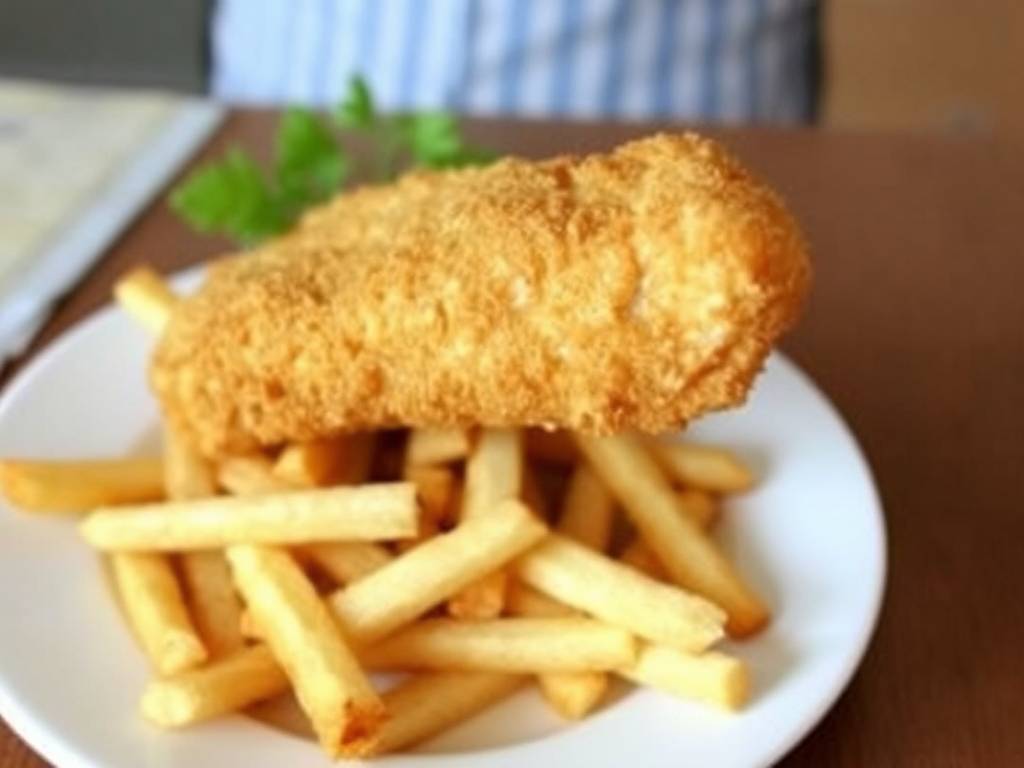The Ultimate Guide to Crafting Perfect British Fish and Chips with Crispy Beer-Battered Fish at Home
There’s something universally comforting about a plate of golden, crispy fish and chips. The satisfying crunch of the batter, the flaky white fish inside, and the perfect companion of thick-cut chips (or fries, as some might call them) is a meal that feels like a warm hug. While you might think this classic British takeaway dish is best left to the professionals, I'm here to show you that creating an incredible, pub-quality version in your own kitchen is not only possible but also incredibly rewarding. Forget soggy, greasy imitations; we're going for perfection.
This guide will walk you through every single step, from choosing the right type of fish to mastering the science of the beer batter and achieving those perfectly fluffy-on-the-inside, crispy-on-the-outside chips. We'll tackle all your potential questions in one go, ensuring you have the confidence to create this iconic dish.

Why a Beer Batter Makes All the Difference
Let's start with the star of the show: the beer-battered fish. You might wonder, "Why use beer? Can't I just use water or milk?" The secret lies in the science of a great fish batter recipe. Beer does three magical things:
- Carbonation: The bubbles in beer are pure carbon dioxide. When the batter hits the hot oil, these bubbles expand rapidly, creating a network of tiny air pockets. This results in a batter that is incredibly light and ethereally crisp, rather than dense and heavy.
- Alcohol: Alcohol evaporates much faster than water. This quick evaporation during frying further contributes to a drier, crispier crust.
- Flavor: Beer adds a subtle, malty, and slightly yeasty flavor that complements the mild taste of white fish perfectly. It’s that undefinable "something" that makes beer-battered fish taste so authentic.
For the best beer for fish batter, you want something light and crisp. A standard lager or pilsner works wonderfully. Avoid dark stouts or heavily hopped IPAs, as their strong flavors can overpower the fish. A simple, cold lager is your best bet for a classic taste.
Selecting Your Fish: The Foundation of the Dish
The traditional choice for British fish and chips is cod or haddock. Both are white, flaky, mild-tasting fish that hold up well to frying.
- Cod: This is the most common choice. It has large, firm flakes and a very mild flavor.
- Haddock: Slightly sweeter and more flavorful than cod, with a texture that is a bit finer. It's a favorite in many parts of the UK.
- Other Options: Pollock, hake, or halibut are also excellent, sustainable alternatives.
No matter which you choose, look for thick, center-cut fillets that are fresh and firm to the touch. If using frozen, ensure they are fully thawed and patted completely dry with paper towels. Moisture is the enemy of crispy batter!
The Art of the Perfect Chip
"Chips" in the context of fish and chips are not the thin, shoestring fries you get with a burger. They are thick-cut, substantial, and have a dual texture: a crispy, golden exterior and a soft, fluffy, almost mashed-potato-like interior.
The best potatoes for chipping are floury varieties like Russets or Maris Pipers. Their high starch and low moisture content is key to achieving that fluffy interior. The secret to perfect homemade chips is a two-stage frying process. Don't worry, it's easier than it sounds and makes a world of difference.
- First Fry (Blanching): This is done at a lower temperature. The goal is to cook the potato all the way through without browning it. This creates that soft, fluffy interior.
- Second Fry (Crisping): This is done at a higher temperature right before serving. This stage creates the golden, crispy exterior we all love.
Your Step-by-Step Guide to Homemade Fish and Chips
Let's get cooking! Here is your foolproof method for making the best fish and chips you've ever had.
Ingredients:
-
For the Chips:
- 4 large Russet or Maris Piper potatoes
- Vegetable or peanut oil, for frying
- Sea salt
-
For the Beer-Battered Fish:

- 4 cod or haddock fillets (about 6 oz each)
- 1 ½ cups all-purpose flour
- 1 teaspoon baking powder (for extra lift)
- 1 teaspoon salt, plus more for seasoning
- ½ teaspoon black pepper
- 1 (12 oz) bottle of cold lager or pilsner
- Extra flour for dredging
Equipment:
- A deep fryer or a large, heavy-bottomed pot (like a Dutch oven)
- Cooking thermometer (this is crucial!)
- Wire rack set over a baking sheet
Instructions:
Part 1: Preparing the Perfect Chips
- Peel and Cut: Peel the potatoes and slice them into thick chips, about ¾-inch thick. Try to keep them uniform in size so they cook evenly.
- Rinse: Place the cut chips in a large bowl and rinse under cold water until the water runs clear. This removes excess surface starch, which prevents them from sticking together.
- Blanch (First Fry): Heat your oil in the pot to 300°F (150°C). Carefully add a batch of the dried chips – don't overcrowd the pot. Fry for 4-5 minutes. They will not be brown, but they will be soft. Remove with a slotted spoon or spider strainer and drain on the wire rack. Repeat with the remaining chips. At this stage, you can let the chips cool completely and hold them for a few hours before the final fry.
Part 2: Crafting the Crispy Beer-Battered Fish
- Dry the Fish: This is the most important step for crispy batter. Pat the fish fillets completely dry with paper towels. Season both sides lightly with salt and pepper.
- Create the Batter: In a large bowl, whisk together the 1 ½ cups of flour, baking powder, 1 teaspoon of salt, and pepper. Slowly pour in the cold beer, whisking gently until just combined. Do not over-mix! A few small lumps are perfectly fine. Over-mixing develops gluten, which will make the batter tough and bready. The consistency should be like thick paint. Place this batter bowl in the refrigerator to keep it cold while you heat the oil.
- Heat the Oil for Frying: Increase the oil temperature to 375°F (190°C). This higher heat is essential for sealing the batter quickly and preventing it from becoming greasy.
- The Dredging Station: Set up your station with your dried fish fillets, a plate with about ½ cup of flour for dredging, and your cold beer batter.
- Fry to Perfection: Dredge a fish fillet in the plain flour, shaking off any excess. This helps the batter stick. Then, dip it into the beer batter, letting the excess drip off for a second. Carefully lower the fish into the hot oil. Fry for 6-8 minutes, turning occasionally, until the batter is deep golden brown and incredibly crisp.
- Drain Properly: Use your slotted spoon to remove the fish from the oil and place it directly on the wire rack. Do not place it on paper towels. Paper towels trap steam and will make the bottom of your beautiful, crispy batter soggy. The wire rack allows air to circulate all around, keeping everything crisp.
Part 3: The Finale
- Second Fry the Chips: Now, with the fish done, bring the oil temperature back to 375°F (190°C). Fry the blanched chips in batches for 2-3 minutes until they are golden brown and crispy. Drain on the wire rack and season immediately with sea salt.
- Serve Immediately: This is a dish that waits for no one. Plate up your golden beer-battered fish and pile the hot chips alongside. Traditional accompaniments include mushy peas, a wedge of lemon, and of course, tartar sauce. For an authentic touch, sprinkle your chips with malt vinegar.
Troubleshooting Common Issues
- Soggy Batter: The oil wasn't hot enough, the fish wasn't dry enough, or the batter was over-mixed. Ensure your oil is at a steady 375°F and your fish is patted bone-dry.
- Greasy Batter: The oil temperature dropped too low when you added the fish. Don't overcrowd the pot; fry in batches to maintain the temperature.
- Batter Falling Off: You didn't dredge the fish in flour first. That light dusting of flour is the glue that holds the batter to the fish.
Creating this classic dish at home is a joyful experience. The sound of the sizzle, the smell of the fry, and the final, glorious crunch are well worth the effort. With this comprehensive guide, you have all the knowledge you need to master the art of fish and chips. So, grab a cold beer for your batter (and maybe one for yourself), and get ready to impress your family and friends with your newfound skills. Happy cooking





发表评论